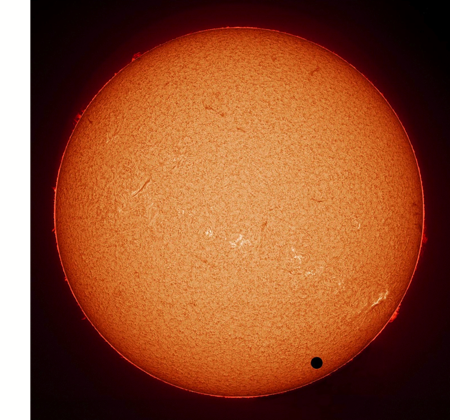Design of Outward Migration of Gas Giant Planets
On June 5–6, 2012, a rare solar system event will occur. Venus will transit across the face of the Sun. Such a transit occurs when Venus aligns perfectly between the Sun and Earth allowing terrestrial observers to see Venus blocking out a portion of the visible disk of the Sun. The NASA image below shows the last Venus transit that occurred on June 8, 2004.

Image credit: NASA
Only once every 130 years, or on alternate cycles every 113 years, do a pair of Venus transits separated by just eight years occur. When Venus does transit the Sun, it dims the amount of sunlight hitting the Earth by about 0.004 percent.
As in our own solar system, transit events by extrasolar planets are relatively rare. While extrasolar transit events cannot be imaged, astronomers can detect them by the degree to which the transiting planet dims the light output of its star.
The first ever detection of an extrasolar transit event was of the planet HD 209458b. This was accomplished in 1999 by a team led by David Charbonneau1 and independently confirmed by a team led by Gregory Henry.2 In the twenty-first century, astronomers discovered 63 other transiting planets. The Kepler space telescope, launched on March 6, 2009, is an instrument dedicated solely to detecting planets in transit. Its sensitivity is so extreme it has the potential to discover over 10,000 transiting planets, even planets as small as Earth. On January 4, 2010, the Kepler science director, William Borucki, announced the discovery of the first five transiting planets detected by the Kepler space telescope.
Astronomers are excited about transiting planets because the transit data gives them much more information about the planets’ characteristics than does the traditional radial velocity planet-detecting method. The radial velocity method finds planets by measuring the degree to which the planet’s gravity tugs the position of its host star away from or toward the astronomer’s telescope as the planet orbits about its star. This method yields the size, period, and eccentricity (or ellipticity) of the planet’s orbit and provides a lower limit on the planet’s mass. The transit method, when combined with the radial velocity method, gives the planet’s actual mass and diameter, and, hence, its density (mass/volume = density). It also delivers the diameter of the host star.
What surprised astronomers about the 64 transiting planets for which they have published measurements is how many have densities lower than Saturn and how low those densities can get. Solar system studies had led astronomers to conclude that Saturn had to be close to the minimum possible planetary density. Planets smaller than Saturn (Saturn’s mass is 95 times greater than Earth’s) would lack the gravity necessary to accrete a huge quantity of light gases like hydrogen and helium while planets larger than Saturn would possess such a powerful gravity as to cause the light gases it does accrete to become compressed. Indeed, the mass of each solar system planet and its distance from the Sun (the solar distance determines the quantity and the temperature of gas in the primordial protoplanetary disk) has proven to be a reliable predictor of that planet’s density.
Of the 64 known and measured extrasolar transiting planets, 25 are less dense than Saturn. Saturn’s density is so low, only 0.687 grams per cubic centimeter, that it would float in water. By comparison, Earth has a density of 5.515 grams per cubic centimeter and Jupiter 1.326 grams per cubic centimeter.
These 25 extrasolar planets manifest a density range from 0.123–0.678 grams per cubic centimeter. Their mean average density is 0.434 grams per cubic centimeter. Moreover, these planets are, for the most part, not low mass gas giants like Saturn. Their mean average mass is more than two and a half times greater than Saturn’s.
Even though the sample size of extrasolar transiting planets is still rather small, it is large enough to affirm conclusions drawn from other studies. In a previous Today’s New Reason to Believe article, I described how astronomers Ansgar Reiners and Mark Giampapa had determined that, compared to the 21 known solar twins and solar analogues that come the closest to matching the Sun’s characteristics, the Sun has a 20 percent depletion of refractory elements (such as aluminum, calcium, magnesium, and silicon) relative to volatile elements (such as carbon, nitrogen, and oxygen).3 Reiners and Giampapa attributed the Sun’s unique elemental abundance to the Sun’s peculiar suite of planets consisting of a few relatively small gas giant planets (volatile-rich planets) at large distances from the Sun and some relatively medium-sized rocky planets (refractory-rich planets) at close-in distances from the Sun.
The analysis of the currently available catalogue of extrasolar transiting planets presented in this article indicates that the Sun’s suite of planets is peculiar in yet another way. The solar system’s least dense planets are proving to be much denser than the least dense planets in extrasolar planetary systems. Such an outcome would be consistent with Reiners and Giampapa’s discovery. That the Sun and its system of planets are proving to possess such rare and unique characteristics strengthens the conclusion that both the Sun and its eight planets were supernaturally designed to make possible the existence of human beings and their high technology civilization on Earth.
Endnotes
- David Charbonneau et al., “Detection of Planetary Transits Across a Sun-Like Star,” Astrophysical Journal Letters 529 (January 20, 2000): L45–L48.
- Gregory W. Henry et al., “A Transiting ‘51-Peg-Like’ Planet,” Astrophysical Journal Letters 529 (January 20, 2000): L41–L44.
- J. Meléndez et al., “The Peculiar Solar Composition and Its Possible Relation to Planet Formation,” Astrophysical Journal Letters 704 (October 10, 2009): L66–L70.




